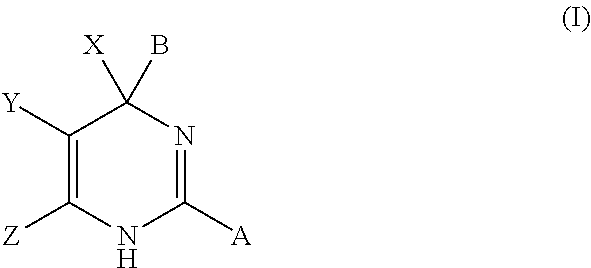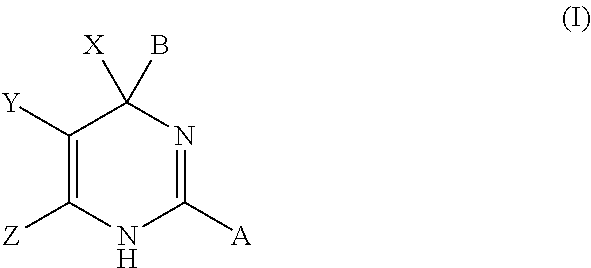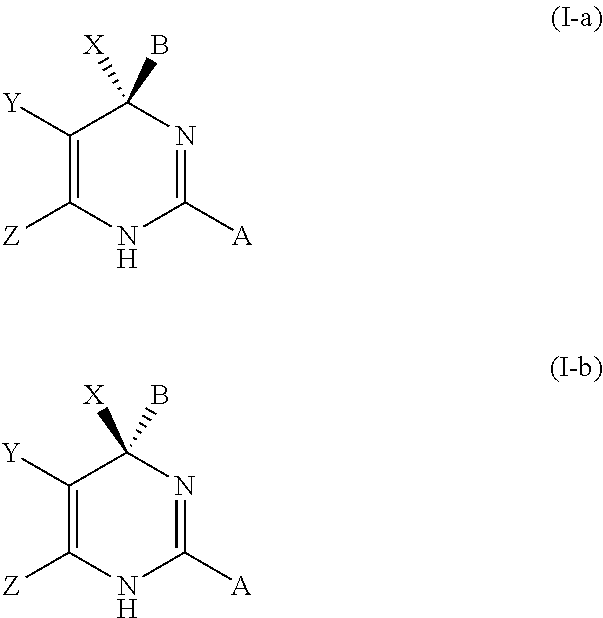Hepatitis b antiviral agents
a technology of antiviral agents and hepatitis b, applied in the field of new antiviral agents, can solve the problems of unmet global medical needs, hbv infection remains a major public health problem, and affects approximately 2 billion people worldwide, and the burden of chronic hbv infection remains a significant unmet global medical problem
- Summary
- Abstract
- Description
- Claims
- Application Information
AI Technical Summary
Benefits of technology
Problems solved by technology
Method used
Image
Examples
example 1
[0160]
Step 1a.
[0161]A mixture of ethyl 3-oxobutanoate (7.61 g, 58.47 mmol), 2-chloro-4-fluorobenzaldehyde (7.76 g, 48.94 mmol), 1,3-thiazole-2-carboximidamide HCl salt (8.0 g, 48.78 mmol) and KOAc (9.56 g, 97.41 mmol) in CF3CH2OH (200 mL) was stirred for 24 hours at 90° C. After being cooled, it was concentrated and the residue was partitioned (EtOAc-brine). The organic was dried (Na2SO4), filtered and concentrated. The residue was chromatographed (silica, ethyl acetate / petroleum ether) to give the desired compound as a yellow solid (8.2 g, 44%). ESIMS m / z=380.2, 382.2 [M+H]+.
Step 1b.
[0162]Into a solution of the compound from step 1a (2.3 g, 6.06 mmol) in CCl4 (40 mL) was charged with NBS (864 mg, 4.85 mol) in portions at 0° C. over 30 minutes. The solution was stirred for 30 minutes at rt before being quenched with water and partitioned (CH2Cl2—H2O). The organic was dried (Na2SO4), filtered and concentrated. The residue was chromatographed (silica, ethyl acetate / petroleum ether) to...
example 2
[0166]
Step 2a.
[0167]The mixture of compound from step 1b (200 mg, 0.44 mmol), (S)-4,4-difluoropyrrolidine-2-carboxylic acid (79 mg, 0.52 mmol) and DIPEA (280 mg, 2.17 mmol) in ClCH2CH2Cl (10 mL) was stirred for 3 hours at rt. it was concentrated and the residue was partitioned (EtOAc-brine). The organic was dried (Na2SO4), filtered and concentrated. The residue was Flash-Prep-HPLC (C18, MeCN / H2O) to give the desired compound as a yellow solid (130 mg, 57%). ESIMS m / z=529.15, 531.15 [M+H]+.
Step 2b.
[0168]Into a solution of step 2a (160 mg, 0.30 mmol), methanesulfonamide (35 mg, 0.37 mmol) and HATU (140 mg, 0.37 mmol) in CH2Cl2 (5 mL) was added DIEPA (50 mg, 0.39 mmol). The resulting solution was stirred for 3 hours at rt. It was partitioned (DCM-brine). The organic was dried (Na2SO4), filtered and concentrated. The residue was Flash-Prep-HPLC (C18, MeCN / H2O) to give the title compound (mixture of diastereomers) as a yellow solid (53.7 mg, 29%). ESIMS m / z=605.9, 607.9 [M+H]+; 1H NMR (D...
example 3
[0169]
Step 3a.
[0170]Into a solution of (S)-1-(tert-butoxycarbonyl)-4,4-difluoropyrrolidine-2-carboxylic acid (500 mg, 1.98 mmol), triethylamine (303 mg, 2.99 mmol) in dichloromethane (10 mL) was added pivaloyl chloride (326.4 mg, 2.39 mmol) dropwise at −15° C. over 10 minutes followed by aqueous ammonia (25%, 5 mL) and was stirred for 1 hour at 0° C. before it was partitioned (CH2Cl2—H2O). The organic was dried (Na2SO4), filtered and concentrated to give the desired compound 602 mg (121%) as off-white liquid. ESIMS m / z=151.2 [M-Boc+H]+. This material was used in the next step without further purification.
Step 3b.
[0171]A solution of crude compound from step 3a (602 mg, 2.40 mmol) and TFA (3 mL) in DCM (1 mL) was stirred 2 hours at rt. It was concentrated to give 612 mg of the desired compound (170%) as yellow oil. ESIMS m / z=151.2 [M+H]+. The material was used directly in the next step without further purification.
Step 3c.
[0172]A solution of compound from step 1b (200 mg, 0.44 mmol), ...
PUM
| Property | Measurement | Unit |
|---|---|---|
| Fraction | aaaaa | aaaaa |
| Fraction | aaaaa | aaaaa |
| Length | aaaaa | aaaaa |
Abstract
Description
Claims
Application Information
 Login to view more
Login to view more - R&D Engineer
- R&D Manager
- IP Professional
- Industry Leading Data Capabilities
- Powerful AI technology
- Patent DNA Extraction
Browse by: Latest US Patents, China's latest patents, Technical Efficacy Thesaurus, Application Domain, Technology Topic.
© 2024 PatSnap. All rights reserved.Legal|Privacy policy|Modern Slavery Act Transparency Statement|Sitemap



